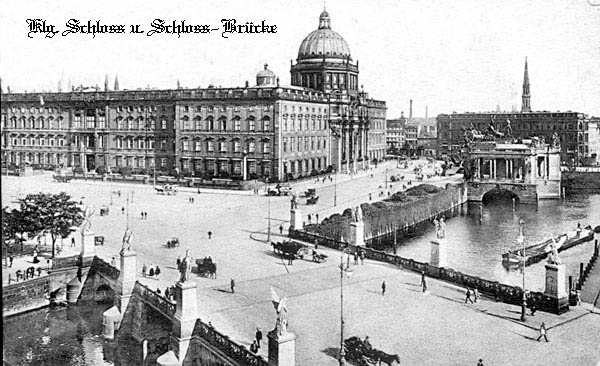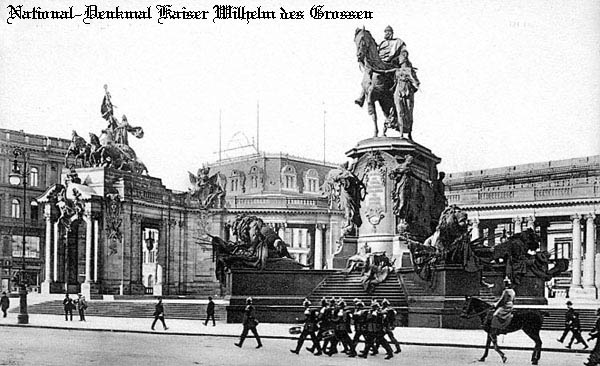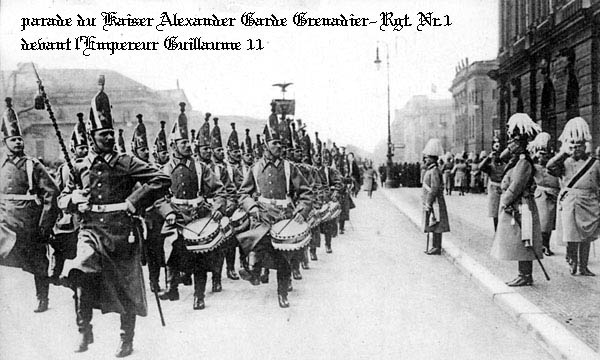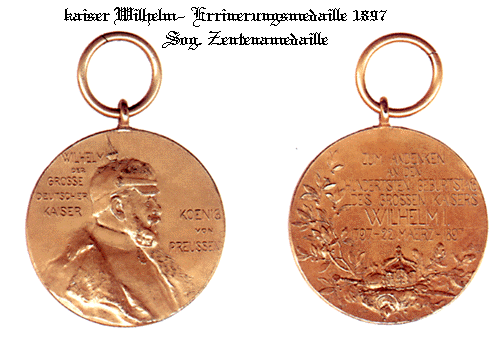
Nr. 002 - National holiday ? march 27th, 1897, centenary
birthday of Wilhelm Ist
Wilhelm II unveil, in Berlin, the national memorial
of "Kaiser Wilhelm der Gross".......his "illustrious-grandfather"
!
Excerpt from: "Guillaume
II intime" by Maurice Leudet, éd. J.Fuven Paris ca.1900
Germans don't have, strictly speaking,
national holiday. However, one can give this title to ceremonies which took
place, in the March 1897, for the Wilhelm Ist centenary, who was proclaimed
German Emperor in Versailles in 1871, by the gathered princes. The national
holiday, reminding our disasters of Sedan, is at least today in the big cities
somewhat fallen in obsolescence.
Therefore, on March 22th of this
year, in presence of the emperor and the empress, rulers or representatives
of all confederate German States, the monument built to the memory of Kaiser
Wilhelm Ist has been inaugurated, in the middle of salvos of cannon-shots and
an incredible popular enthusiasm.
That day, the central streets of
Berlin taking to the royal castle had been closed to the trafic by police and
infantry cordons, so that the official personalities could make way themselves
easily, as well as thousand of privileged who had been allowed to attend this
spectacle. This is how the walk of the Unter den Linden was occupied by the
troops who had to parade after the ceremony in front of Wilhelm II and the monument
of his grandfather. .
 The castle is placed on a long and narrow
island formed by two arms of the Spree. The west side of the building is parallel
to one of these stream arms, and separated by the roadway known as Schlossfreiheit.
Between the Schlossfreiheit and water, there were. once, a suite of old buildings
the only interest of which resided in the picturesque side they presented.
The castle is placed on a long and narrow
island formed by two arms of the Spree. The west side of the building is parallel
to one of these stream arms, and separated by the roadway known as Schlossfreiheit.
Between the Schlossfreiheit and water, there were. once, a suite of old buildings
the only interest of which resided in the picturesque side they presented.
Those buildings were bought and
have been demolished six years ago, to build in place the Wilhelm I memorial,
whose expenses would be covered by means of a big lottery. This place had not
been chosen without previously giving place to discussions and the political
controversies.
Already in March 1888, fifteen days
after Guillaume I death, the imperial diet unanimously decided to raise a memorial
to the memory of the founder of the German empire. A special commission was
named, and a competition of projects was decided in which architects and sculptors
might take part. Different projects were exposed, but although several of authors
had been paid very dear, no one was ageed by the emperor and his advisors on
the shape to give to the monument. Himself Wilhelm II, expressed the opinion
that the square of the Scholssfreiheit was best choose, but he declared one's
hostile to all proposed architectural plans.
Some projects consisted in completely
destroying the Brandenburg Tor and to rebuild the big square in which it drives:
the Pariser Platz. The imperial diet ended up deciding that alone the emperor
would take a determination. Wilhelm II chose, as a site, the Schlossfreiheit,
and addressed himself to the sculptor Reinhold Begas for the execution. But,
when it is about process and means, the diet, by opposition spirit, appeared
thrifty. Instead of voting eight millions of marks for the monument, it only
agreed to grant the half : four millions. The government was far from being
satisfied of this voting, but professor Begas agreed to undertake the works
in the fixed financial limits.
 Professor
Begas built a semi-circular double colonnade. The whole building is placed on
a sandstone platform and stoutly sustained by a wall of solid masonry on the
riverside. Each end of the semi-circular colonnade is surmounted of triumphal
chariots driven by four steeds in bronze. In each of them, an allegorical figure
is placed, holding an expanded flag and representating, one the North Germany,
the other the South Germany. The colonnade is decorated of many other groups
and symbolic figures, of which some represents the kingdoms constituting the
German empire : Prussia, Bavaria, Saxony and Würtemberg. The other symbolic
groups represent the art, science, agriculture, industry and navigation. This
colonnade of white sandstone was what hit the most the eyes of the spectators
gathered by thousands on the platforms put up on both sides of the Cosander
Door along the west facade of the castle.
Professor
Begas built a semi-circular double colonnade. The whole building is placed on
a sandstone platform and stoutly sustained by a wall of solid masonry on the
riverside. Each end of the semi-circular colonnade is surmounted of triumphal
chariots driven by four steeds in bronze. In each of them, an allegorical figure
is placed, holding an expanded flag and representating, one the North Germany,
the other the South Germany. The colonnade is decorated of many other groups
and symbolic figures, of which some represents the kingdoms constituting the
German empire : Prussia, Bavaria, Saxony and Würtemberg. The other symbolic
groups represent the art, science, agriculture, industry and navigation. This
colonnade of white sandstone was what hit the most the eyes of the spectators
gathered by thousands on the platforms put up on both sides of the Cosander
Door along the west facade of the castle.
Against the Cosander Door itself,
a wooden construction, having just about the shape of a throne, had been erected,
with staircases leading to it and a magnificent canopy covering the whole. Staircases
were covered of red material, and the canopy edged of golden braids. This canopy
was reserved to the empress, to the empress Frederick (the daughter of Queen
Victoria of England,she was the Wilhelm II's mother), to the Prussian princesses,
to the German rulers, etc. On the platform of the memorial, one could see hundred
deputies of the Prussian and imperial diet and, innumerable groups of black
dresses, among brilliant officers uniforms. Quite to the center, the equestrian
statue of Wilhelm I, still veiled to the looks of the crowd. A dozen of soldiers
stood at the foot of statue ready to discover it at the first signal.
 During
this time, the emperor, accompanied by his aide-de-camps and general von Winterfeld,
commander of the corps of the guards, rode along of the troop line in the Unter
den Linden until the Brandenburger Tor, while music played a military march.
He stopped in front of his grandfather's palace, where he entered to make going
out the corps of the guard and the other regiments of the German army which
had been the object of special favors of the old emperor Wilhelm I. Getting
to the head of a company of guard grenadiers, the emperor, came back to the
castle and stood before the royal canopy, facing the monument. Grenadiers, with
their jerky parade pace, marched in front him and took place to the right of
the statue, the young crown-prince and his brother Eitel-Friedrich holding to
their rank of lieutenants of company.
During
this time, the emperor, accompanied by his aide-de-camps and general von Winterfeld,
commander of the corps of the guards, rode along of the troop line in the Unter
den Linden until the Brandenburger Tor, while music played a military march.
He stopped in front of his grandfather's palace, where he entered to make going
out the corps of the guard and the other regiments of the German army which
had been the object of special favors of the old emperor Wilhelm I. Getting
to the head of a company of guard grenadiers, the emperor, came back to the
castle and stood before the royal canopy, facing the monument. Grenadiers, with
their jerky parade pace, marched in front him and took place to the right of
the statue, the young crown-prince and his brother Eitel-Friedrich holding to
their rank of lieutenants of company.
Almost to the same moment, the
empress and the empress Frederick with other royal or imperial house personalities,
appeared in the imperial pavilion. The emperor gave the command then: Beat the
drums. Immediately drums resounded and trumpets played the favorite hymn of
Wilhelm II: "Wir treten zum Beten von Gott dem Gerechten", (We are going to
pray God the Just). Then the Lutheran pastor Dr Faber pronounced the prayer
of consecration of the monument. Hardly the finished speech, the emperor took
his sword out its scabbard and after having made troops present arms, he exclaimed
lout: "That the veil that covers the statue fall". And the statue appeared to
the public, while Wilhelm Guillaume II saluted with the sword and all soldiers
and officers made the military salute. .
The statue, in bronze, represents
Wilhelm as he was in his 70 to 80. He wears the Prussian general full dress
with the spiked-helmet. The horse he rides is driven by a genius, under the
shape of a beautiful Gretchen, holding a branch of palm in her hand.
The pedestal is also in bronze,
laying on a cruciform block of granite; on each side of this block is a magnificent
lain down lion. In front and behind the pedestal escutcheons are placed, on
which are written down words: " To Wilhelm the Great, king of Prussia, 1861
1888 ". "Acknowledgemen and faithful affection - the German people" . At every
corner, allegorical figures of the Victory. On the sides, one sees two symbolic
scenes representing War and Peace. On one hand, the Fury of the War, represented
by a warhorse galloping in the middle of storm and lightnings, stomps in her
mad race, a field of wheat. Two demons come with him, armed of a sword and a
whip. The Peace appears under a girl's features, hairs in the wind, going down
the mountains in the valley. To its sides, two children are walking, one with
a branch of palm in the hand, the other with a basket of flowers on his head,
flowers whose Peace strews the road.
The total height of the monument
is sixty five feet and half (22m), the equestrian statue of the emperor measures
twenty nine feet (10m).
During a certain time, after the
veil covering the building had been removed, the emperor remained on horseback
still, in the position of salute with the sword, while drummers were beating,
troops were cheerings heard and that military musics played "Heil dir im Siegerkranz.
At the same time, a salvo of hundred one cannon-shots was fired and all bells
of the city rang. The German rulers, the foreign princes, among whom the duke
of Connaught, and regiments deputation advanced close to the monument and put
down magnificent wreath there. The empress and the empress dowager Frédéric
also approached and examined it from all sides. The ceremony ended by the choir
Lob dem Herrn (Praises to the Lord), played by trumpets.
 To this moment, the emperor went back, and all troops, including detachments
of marine infantry and sailors, got marching on. All men carried a commemorative
medal made of the bronze of cannons taken us during the terrific year. In the
evening, a banquet in the castle gathered the princes, the foreign ambassadors,
the chancellor of the empire and the Prussian ministers. After the banquet,
there was a gala at the opera where a play of the court favorite dramatist,
Ernest Wildenbruch was performed.
To this moment, the emperor went back, and all troops, including detachments
of marine infantry and sailors, got marching on. All men carried a commemorative
medal made of the bronze of cannons taken us during the terrific year. In the
evening, a banquet in the castle gathered the princes, the foreign ambassadors,
the chancellor of the empire and the Prussian ministers. After the banquet,
there was a gala at the opera where a play of the court favorite dramatist,
Ernest Wildenbruch was performed.
This allegorical piece in four tableaux,
having for title Willehalm. Main roles were: Willehalm in his youth, in his
mature age and in his old age, the emperor who is obviously Napoléon Ist, Lutetia
and the German war men.
German people divisions, kept by
the Emperor, are ended by Willehalm - Wilhelm Ist- to whom Wildenbruch the work
of dedicates the apotheosis. In the royal box to the right of the emperor in
full dress uniform, always solemn in these opportunities, and of the empress,
stood princess Luitpold-Friedric and the king of Saxony; to their left, the
regent of Bavaria, prince Luitpold, and the king of Würtemberg. The duke of
Connaught, the grat duke Wladimir, the heir prince of Sweden, the heir prince
of Romania. Other famous guests occupied the second and the third rank of the
royal box.
As for the city of Berlin, it was
illuminated all whole in sign of joy; memories of a victorious war: brought
closer in one same impetus of enthusiasm, all parties from center to the socialists.
Naturally, during the banquet, Kaiser
Wilhelm II, who likes to appear and….. to speak, pronounced a speech, less warlike
besides that one waited there in similar circumstance. However, the emperor
was not able to stop himself from recalling the misfortunes of the Prussian
royalty during the time of the Napoleonic wars.
" We think today, he exclaimed,
of the humility of my great-father, of his habits of simplicity and his love
of well accomplished duty, and let's not forget he was the son of this noble
and respectable queen, queen Louise, of whom one has said, she learned more
at the school of the humiliation than to the one of success...
" For it's true that Wilhelm II,
Emperor of a people united by the victory, doesn't lose an opportunity to remind
this people of the defeats that inflicted it once the great French Emperor…..
.
Page sommaire
du Uhlan on the web
page mise à jour le 1/09/2000
![]()
 The castle is placed on a long and narrow
island formed by two arms of the Spree. The west side of the building is parallel
to one of these stream arms, and separated by the roadway known as Schlossfreiheit.
Between the Schlossfreiheit and water, there were. once, a suite of old buildings
the only interest of which resided in the picturesque side they presented.
The castle is placed on a long and narrow
island formed by two arms of the Spree. The west side of the building is parallel
to one of these stream arms, and separated by the roadway known as Schlossfreiheit.
Between the Schlossfreiheit and water, there were. once, a suite of old buildings
the only interest of which resided in the picturesque side they presented.
 Professor
Begas built a semi-circular double colonnade. The whole building is placed on
a sandstone platform and stoutly sustained by a wall of solid masonry on the
riverside. Each end of the semi-circular colonnade is surmounted of triumphal
chariots driven by four steeds in bronze. In each of them, an allegorical figure
is placed, holding an expanded flag and representating, one the North Germany,
the other the South Germany. The colonnade is decorated of many other groups
and symbolic figures, of which some represents the kingdoms constituting the
German empire : Prussia, Bavaria, Saxony and Würtemberg. The other symbolic
groups represent the art, science, agriculture, industry and navigation. This
colonnade of white sandstone was what hit the most the eyes of the spectators
gathered by thousands on the platforms put up on both sides of the Cosander
Door along the west facade of the castle.
Professor
Begas built a semi-circular double colonnade. The whole building is placed on
a sandstone platform and stoutly sustained by a wall of solid masonry on the
riverside. Each end of the semi-circular colonnade is surmounted of triumphal
chariots driven by four steeds in bronze. In each of them, an allegorical figure
is placed, holding an expanded flag and representating, one the North Germany,
the other the South Germany. The colonnade is decorated of many other groups
and symbolic figures, of which some represents the kingdoms constituting the
German empire : Prussia, Bavaria, Saxony and Würtemberg. The other symbolic
groups represent the art, science, agriculture, industry and navigation. This
colonnade of white sandstone was what hit the most the eyes of the spectators
gathered by thousands on the platforms put up on both sides of the Cosander
Door along the west facade of the castle.
 During
this time, the emperor, accompanied by his aide-de-camps and general von Winterfeld,
commander of the corps of the guards, rode along of the troop line in the Unter
den Linden until the Brandenburger Tor, while music played a military march.
He stopped in front of his grandfather's palace, where he entered to make going
out the corps of the guard and the other regiments of the German army which
had been the object of special favors of the old emperor Wilhelm I. Getting
to the head of a company of guard grenadiers, the emperor, came back to the
castle and stood before the royal canopy, facing the monument. Grenadiers, with
their jerky parade pace, marched in front him and took place to the right of
the statue, the young crown-prince and his brother Eitel-Friedrich holding to
their rank of lieutenants of company.
During
this time, the emperor, accompanied by his aide-de-camps and general von Winterfeld,
commander of the corps of the guards, rode along of the troop line in the Unter
den Linden until the Brandenburger Tor, while music played a military march.
He stopped in front of his grandfather's palace, where he entered to make going
out the corps of the guard and the other regiments of the German army which
had been the object of special favors of the old emperor Wilhelm I. Getting
to the head of a company of guard grenadiers, the emperor, came back to the
castle and stood before the royal canopy, facing the monument. Grenadiers, with
their jerky parade pace, marched in front him and took place to the right of
the statue, the young crown-prince and his brother Eitel-Friedrich holding to
their rank of lieutenants of company.
 To this moment, the emperor went back, and all troops, including detachments
of marine infantry and sailors, got marching on. All men carried a commemorative
medal made of the bronze of cannons taken us during the terrific year. In the
evening, a banquet in the castle gathered the princes, the foreign ambassadors,
the chancellor of the empire and the Prussian ministers. After the banquet,
there was a gala at the opera where a play of the court favorite dramatist,
Ernest Wildenbruch was performed.
To this moment, the emperor went back, and all troops, including detachments
of marine infantry and sailors, got marching on. All men carried a commemorative
medal made of the bronze of cannons taken us during the terrific year. In the
evening, a banquet in the castle gathered the princes, the foreign ambassadors,
the chancellor of the empire and the Prussian ministers. After the banquet,
there was a gala at the opera where a play of the court favorite dramatist,
Ernest Wildenbruch was performed.